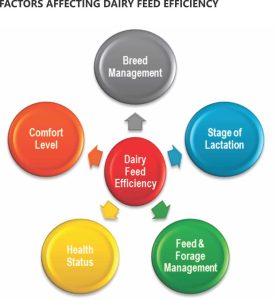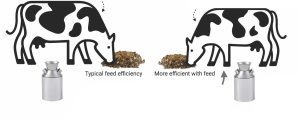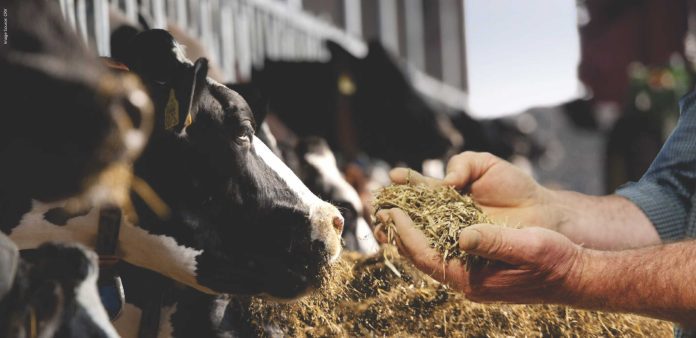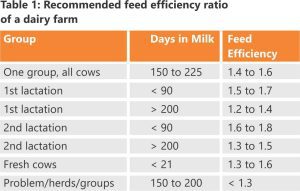INTRODUCTION
Feed efficiency is defined as the relative ability of a dairy cow to convert feed nutrients into milk components. Feed efficiency relates to the term dairy efficiency and dry matter efficiency. It is measured by a simple mathematical formula as kg of milk produced per kg of dry matter consumed by a dairy cow. When the feed efficiency concept is applied, efficient utilization of nutrients was followed by less percentage of nutrients excreted through dung.
This makes the cow highly efficient in withdrawing energy from a well balanced complete diet. Therefore, there is a rationale in optimizing the dry matter intake rather than maximizing the dry matter intake of dairy cows. It helps the nutritionist and dairy farmers to manage the cost of feeding caused by price fluctuation around the year, and results in fetching higher income over the feed cost.


Various factors must be considered before calculating the feed efficiency at a dairy farm.
- Dry matter intake (DMI) is estimated by quantifying the feed offered and feed residue every day. Whereas, the dry matter of green fodder and silage is monitored weekly.
- Milk yield in dairy animals has different fat and solid not fat (SNF) concentrations. Hence, this quantity of milk is converted into universally accepted energy-corrected milk (ECM) by using the mathematical formula below.
ECM = [12.82 × fat (kg)] + [7.13 × protein (kg)] + [0.323 × milk (kg)]
Feed efficiency = ECM/ DMI
This method of calculating feed efficiency focuses on the ability of a dairy animal to produce milk efficiently. Feed efficiency can also be calculated by determining kg of milk produced per mega calories of feed consumed by dairy animals.
- Breed Management: Genetics determine the milk-producing ability of a dairy animal. Crossbreeding improves the genetic makeup of an animal to live a healthy life and become an efficient converter of forage-based ration to milk.
- Stage of lactation: Physiological state of a dairy animal also has a bigger impact on its ability to produce milk efficiently. In early lactation, a dairy animal is in negative energy balance (NEB) and the body weight is lost daily by the animal. The lost energy of the body is used to produce milk. However, during the later part of lactation, cattle usually shows a gain body with lower feed efficiency. So, towards the later part of lactation, the decrease in milk production is also followed by decrease in feed efficiency.
The following table indicates the feed efficiency in different stages of lactation.
- Feed and Forage Management: Optimization of nutrients in feed formulation and providing a balanced ration as per the animals’ requirement is essential to get optimum feed efficiency. Exogenous incorporation of feed additives like yeast and enzymes in the ration may also improve the overall feed efficiency. It has been also shown that feed efficiency is directly related to forage digestibility. To achieve a high feed efficiency for a dairy herd, high-quality forage is essential. As neutral detergent fiber (NDF) percentage increases, feed efficiency decreases and remains constant when NDF in the total diet is 35% or above.
- Health Status: The health status of an animal also plays an important role in determining feed efficiency. If the animal is in any disease condition, its feed efficiency will be lowered. Similarly, if the body condition score (BCS) of an animal is different than usual, lowered feed efficiency may be observed.
- Comfort Level: Animals’ behavior plays a vital role in improving feed efficiency. Stress increases the energy and protein requirement for maintenance. Hence, body organs starve despite normal blood glucose levels. Therefore, the efficiency of milk production falls. Chromium as a trace mineral additive increases glucose uptake by body organs despite low insulin, and thus, improves dairy efficiency.
IMPROVEMENT OF DAIRY FEED EFFICIENCY
Good Management Practices:
Management of dairy farms plays a vital role in improving feed efficiency. A healthy cow is always a more efficient milk producer when compared to a malnourished cow. A balanced ration should provide protein, energy, minerals, and vitamins from dry fodders, green fodders, concentrates, mineral supplements, etc., in appropriate quantities to enable the animal to perform optimally and remain healthy.
Feed additives:
a. Active Dry Yeast:
Yeast has been used in dairy cattle nutrition for a long time. Various forms of yeast are commercially available, which include yeast cell walls, yeast lysates, yeast metabolites, yeast cultures, and active dry or live yeast. Among them, the inclusion of rumen-specific active dry yeast in the dairy cattle ration has shown a significant improvement in overall rumen health and feed efficiency when compared to other forms of yeast. Rumen-specific active dry yeast act as a probiotic and helps in scavenging available oxygen inside the rumen subsequently making the rumen environment more anaerobic and favorable to microflora growth.
Recently, the focus of researchers has been moved towards complementing the benefits of active dry yeast with some other essential nutrients, for example, chromium, selenium, etc. Chromium is an important nutrient for insulin-mediated glucose absorption and combining active dry yeast with chromium complements its effect of improving nutrient absorption and dry matter intake that reflects in the overall improvement in animal health and performance. Recent field trials have shown a maximum return on investment (RoI) of 3:1 while using rumen-specific active dry yeast with chromium.
b. Enzymes:
Forages account for 40 to 100% of the ration of dairy cows. Fiber plays a vital role in animal productivity and health. A one-unit increase in forage-neutral detergent fiber digestibility (NDFD) is associated with 0.17 and 0.25 kg/d increases in DMI and milk production, respectively.
The addition of exogenous enzymes in ration not only improves fiber digestion but also improves dry matter digestibility. Enzymes tend to increase feed efficiency by acting on the most limiting nutrient of the diet, i.e., by unlocking the energy of the undigested portion of the ration.
Thus, it improves the energy nutrition of the ration and the dairy efficiency of the farm becomes profitable. A combination of Xylanase potentiating factor (XPF) and non-starch polysaccharides (NSP) enzymes is able to harness the full energy from NSP of cattle feed, which results in feed optimization and increased milk production and milk fat%, which has proven by minimum RoI of 3:1.
c. Rumen Protected Amino Acids (RPAAs) – Methionine (Met) and Lysine (Lys):
Methionine and lysine are the first and second limiting amino acids in the ruminant diet, respectively. When rumen-protected Met & Lys are incorporated in ration through amino acid balancing, it tends to improve milk yield and milk composition, thus filling the gap of amino acid deficiency in the diet, and thereby, improving feed efficiency and nitrogen utilization efficiency. Amino acid balancing helps in lowering crude protein of ration around 2% and helps to obtain similar results to earlier crude protein (CP) levels.
d. Toxin-binder:
Diverse climatic conditions and volatile raw material prices lead to increased incidences of mycotoxins in cattle feed. Mycotoxins such as aflatoxins, zearalenone, ochratoxins, fumonisins, etc. are not only harmful to the animal but are equally harmful to humans.
According to Kemin’s internal survey, more than 80% of cattle feed was found contaminated with more than the permissible limit (20 ppb) of Aflatoxin B1 which leads to the lowered health status of the dairy animals and ultimately poor feed efficiency. Toxin binders are recommended to be added to the ration of dairy cattle to avoid the harmful impact of mycotoxins and have been found to be effective in the ruminal environment to bind with toxins and remove them outside the animal body through dung. In this process, toxin binders also improvise palatability and feed intake, thus increasing overall feed efficiency.


Continuous fluctuations in raw material prices and increasing operational expenses lead to reduced feed efficiency and overall animal performance. We are having a great opportunity in terms of improving feed efficiency that will help to optimize the economics of commercial dairy farming. Good management practices and the usage of specialty feed additives in the ration are the most important tools to improve feed efficiency.
By Manish Pathak and Sudhir Kumar Singh, Kemin Industries South Asia















